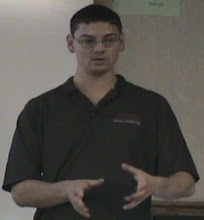Thursday, January 28, 2010
Quantum Cellular Automata and Grover's Algorithm
I just came across this paper on arXiv: "Quantum Algorithm of Evolutionary Analysis of 1D Cellular Automata" by Pavlyshenko. It is a quick read (7 pages), and basically discusses using elements of Grover's algorithm to see if certain states of a cellular automata evolution exist.
Wednesday, January 20, 2010
D'Hondt and Vandriessche: Distributed Quantum Programming
D'Hondt and Vandriessche have posted a paper on arXiv titled Distributed Quantum Programming. The technique the paper describes is pretty mathematical, so I wouldn't classify it as a "practical" approach to quantum programming. Nonetheless, it is great to see continued work in the subject. At the end of the paper they discuss a "distributed quantum virtual machine", which is also worth checking out. Good to see details of how we may actually interact with quantum computers in standard way- taking Knill's QRAM a step farther. They also describe a GUI for the quantum virtual machine's design tool:
 (Image is from the paper itself.)
(Image is from the paper itself.)
Here's the abstract of the paper:
 (Image is from the paper itself.)
(Image is from the paper itself.)Here's the abstract of the paper:
In this paper we explore the structure and applicability of the Distributed Measurement Calculus (DMC), an assembly language for distributed measurement-based quantum computations. We describe the formal language’s syntax and semantics, both operational and denotational, and state several properties that are crucial to the practical usability of our language, such as equivalence of our semantics, as well as compositionality and context-freeness of DMC programs. We show how to put these properties to use by constructing a composite program that implements distributed controlled operations, in the knowledge that the semantics of this program does not change under the various composition operations. Our formal model is the basis of a quantum virtual machine construction for distributed quantum computations, which we elaborate upon in the latter part of this work. This virtual machine embodies the formal semantics of DMC such that programming execution no longer needs to be analysed by hand. Far from a literal translation, it requires a substantial concretisation of the formal model at the level of data structures, naming conventions and abstraction mechanisms. At the same time we provide automatisation techniques for program specification where possible to obtain an expressive and user-friendly programming environment.
Thursday, January 14, 2010
SA: The Next 20 Years of Microchips
 Scientific American has published an article in this month's (January 2010) issue titled The Next 20 Years of Microchips: Pushing Performance Boundaries. It gives a good 50,000 foot overview (about half a page each) to several areas computers will probably move into over the next decade or two. Quantum computing is mentioned as one of them, and the fact that they've been writing about the subject often recently reflects the growing interest in the field. The article also covers other topics such as optical and biological computing.
Scientific American has published an article in this month's (January 2010) issue titled The Next 20 Years of Microchips: Pushing Performance Boundaries. It gives a good 50,000 foot overview (about half a page each) to several areas computers will probably move into over the next decade or two. Quantum computing is mentioned as one of them, and the fact that they've been writing about the subject often recently reflects the growing interest in the field. The article also covers other topics such as optical and biological computing.If you're a graduate student looking for a research area, I recommend checking out this article. Picking a "bleeding edge" subject means there is still a lot of work to be done- and this article mentions a lot of these subjects. This can make identifying a particular niche to fill much easier, and obviously there is less of a chance of someone doing the same thing in parallel. (A classic doctoral student fear: having someone else publish the same thing right before you finish.) Not only does it make things easier, but I personally found it extremely interesting and rewarding working on a topic that is ahead of the curve.
Monday, January 4, 2010
An Overview of Quantum Computing for Technology Managers
I came across this paper on arXiv: An Overview of Quantum Computing for Technology Managers by Eleanor G. Rieffel. It provides a good overview of nearly all aspects of quantum computing. Unfortunately the one area missing was quantum computer programming. It is great to have algorithms and physical implementations, but we still need a way to write code to carry those algorithms out. The closest was the coverage of quantum circuit diagrams. If it were to be expanded in the future to cover quantum computer programming, I would imagine that Knill's QRAM model [1] would play a big part since it is used (sometimes implicitly) in many programming proposals.
This paper is also part of Wiley's Handbook of Technology Management.
References
[1] E. Knill, "Conventions for Quantum Pseudocode," Los Alamos National Laboratory LAUR-96-2724, 1996.
This paper is also part of Wiley's Handbook of Technology Management.
References
[1] E. Knill, "Conventions for Quantum Pseudocode," Los Alamos National Laboratory LAUR-96-2724, 1996.
Subscribe to:
Posts (Atom)
